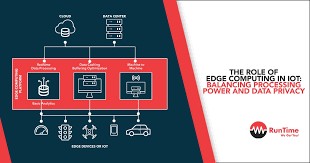
Edge computing is reshaping the way data is processed, stored, and acted upon in today’s increasingly connected world. As digital devices proliferate and generate vast amounts of information, traditional centralized models of data processing—where everything is sent to the cloud or a data center—are struggling to keep pace. Latency, bandwidth limitations, and real-time responsiveness have become critical concerns, especially in industries where decisions must be made instantly. Edge computing addresses these challenges by bringing computation closer to the source of data, enabling faster insights and more efficient operations.
The essence of edge computing lies in decentralization. Instead of relying solely on distant servers, data is processed locally—on devices, gateways, or nearby nodes—before being sent to the cloud for further analysis or storage. This shift reduces the time it takes for data to travel, which is particularly valuable in applications like autonomous vehicles, industrial automation, and healthcare monitoring. For example, a self-driving car cannot afford the delay of sending sensor data to a remote server and waiting for a response. Edge computing allows it to analyze conditions in real time, making split-second decisions that could mean the difference between safety and disaster.
In manufacturing environments, edge computing enables predictive maintenance and quality control by analyzing data from sensors embedded in machinery. Instead of transmitting every data point to a central system, edge devices can detect anomalies and trigger alerts immediately. This not only conserves bandwidth but also minimizes downtime and improves operational efficiency. Similarly, in retail, edge computing powers smart shelves and real-time inventory tracking, allowing stores to respond dynamically to customer behavior and stock levels. These localized insights help businesses stay agile and responsive without overwhelming their networks.
Healthcare is another sector where edge computing is making a significant impact. Wearable devices and remote monitoring tools generate continuous streams of patient data, from heart rate to glucose levels. Processing this data at the edge ensures timely alerts and interventions, which can be critical in managing chronic conditions or responding to emergencies. Moreover, it enhances privacy by limiting the amount of sensitive information transmitted over networks. Patients benefit from personalized care, and providers gain access to actionable insights without compromising security.
The rise of edge computing also aligns with the growth of the Internet of Things. As billions of connected devices come online, the need for scalable, efficient data processing becomes more urgent. Edge computing provides the infrastructure to support this expansion, allowing devices to operate autonomously and collaboratively. In smart cities, for instance, traffic lights, surveillance cameras, and environmental sensors can work together to optimize urban flow and safety. By processing data locally, these systems reduce congestion, improve resource allocation, and enhance the quality of life for residents.
From a business perspective, edge computing offers strategic advantages beyond technical performance. It enables organizations to deliver better customer experiences by reducing latency and improving responsiveness. It also supports compliance with data sovereignty regulations, which require certain data to be processed within specific geographic boundaries. By keeping data closer to its origin, companies can navigate regulatory landscapes more effectively while maintaining operational continuity. Additionally, edge computing can reduce costs associated with cloud storage and data transmission, making it a financially prudent choice for many enterprises.
However, implementing edge computing is not without its challenges. It requires a rethinking of architecture, security, and management practices. Organizations must ensure that edge devices are secure, reliable, and capable of handling complex tasks. They also need to establish protocols for data synchronization, backup, and recovery to maintain consistency across distributed systems. Integration with existing infrastructure and cloud services must be seamless to avoid fragmentation and inefficiencies. These considerations demand careful planning and collaboration across IT, operations, and strategic leadership.
The evolution of edge computing is also driving innovation in hardware and software. Lightweight, energy-efficient processors are being developed to support edge workloads, while specialized platforms are emerging to manage distributed environments. Artificial intelligence and machine learning are increasingly being deployed at the edge, enabling devices to learn and adapt in real time. This convergence of technologies is creating new possibilities for automation, personalization, and intelligent decision-making. Businesses that embrace these advancements can unlock new value and differentiate themselves in competitive markets.
Ultimately, the role of edge computing in data processing is about enabling smarter, faster, and more localized decision-making. It empowers organizations to harness the full potential of their data without being constrained by distance or delay. As digital transformation accelerates across industries, edge computing will play a pivotal role in shaping how information is used to drive outcomes. It’s not just a technical shift—it’s a strategic evolution that reflects the changing demands of a connected, data-driven world. By embracing edge computing, businesses position themselves to thrive in an environment where speed, efficiency, and insight are paramount.